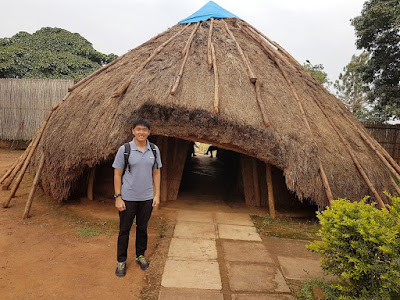JPN: Kyoto Downtown
Kyoto City, Kyoto, Japan


Kyoto, the former imperial capital of Japan known as Heian-kyo, holds an enduring allure for visitors with its seamless blend of ancient traditions and modernity. As mentioned earlier, I don't have a lot of photos to share this time round, but I'll split the story into three posts. The first one here shall cover a few attractions near the downtown area.
---
JPN: Kyoto Downtown <YOU ARE HERE!>
---
One of the iconic landmarks of the downtown area is Kyoto Tower. Soaring 131 m into the sky, the observation tower was completed in 1964, just in time for the Summer Olympics in Tokyo. My family and I didn't go up to the observation deck, but we had lunch at the food court.
 |
| At the point of writing, admission to the observation deck costs ¥900 (~S$8.05) per adult. |
On one of the afternoons, we decided to indulge in ekiben (Japanese meal boxes sold at train stations). It was fun navigating through the array of kiosks at Kyoto station.
Spanning an impressive thirteen floors, JR Kyoto Isetan is a prominent shopping haven that's directly linked to Kyoto station. For those unable to visit the main branch of Nakamura Tokichi renowned for its green tea offerings, the Isetan outlet presents a convenient alternative.
After dropping our luggage at Sotetsu Fresa Inn Kyoto Station Hachijo-guchi that's easily accessible by foot from the east entrance of Kyoto station, we had a refreshing morning walk to To-ji, a Shingon Buddhist temple founded in 796.
 |
| It was one of only three Buddhist temples allowed in the capital at the time. |
There was a weekend bazaar at the grounds of the temple.

 |
| Most of them looked like pre-loved items. |
 |
| Piping hot oden (Japanese fish cake stew), anyone? |
Reaching a height of 54.8 m, the five-storey pagoda there stands as the tallest wooden structure in Japan.
From there, we strolled to the sprawling park called Umekoji, which literally means 'plum alley'. Of course we didn't get to see the enchanting sight of vibrant plum blossoms that'd only appear in spring, but we were captivated by the autumn foliage nonetheless.
 |
| The park was officially opened in 1995. |
 |
| Acer palmatum is the scientific name for the Japanese maple. |
Our journey also led us to the iconic Fushimi Inari Taisha, which is well-known for its mesmerising rows of torii (Shinto shrine gates). That marked my second visit, and since both occasions took place in the evening, the opportunity to ascend all the way to the summit has yet to present itself.
 |
| The shrine is located just outside the Inari station, a five-minute ride from Kyoto station. |
 |
| Inari is primarily the Shinto god of rice and agriculture. |

Inari is also revered by numerous merchants as the patron deity of business. Each of the thousands vermillion torii adorning the path was donated by a Japanese business as a symbolic gesture to seek blessings and prosperity.
 |
| The custom to donate a torii began spreading from the Edo period in 1603. |
Head over to my food blog to discover the following eateries that we visited:
- Curry House CoCo Ichibanya (Japanese)
- Ekiben Tabi Bento (Japanese)
- Nakamura Tokichi (Japanese)
- Nishiki Uoriki @ Kyoto Tower Sando (Japanese)





















Comments
Post a Comment